
Concept explainers
(a)
Calculate the design wind load, base shear, and overturning moment.
(a)
Answer to Problem 18P
The resultant force acting on roof slab is
The resultant force acting on second floor is
The seismic base shear is
The overturning moment is
Explanation of Solution
Given information:
The importance factor (I) is 1.15.
The value of
The mean roof height is 30 ft.
The height of the single floor (h) is 15 ft.
The basic wind speed is
The exposure is D.
Calculation:
Consider the exposure of the D.
Refer Table 2.9, “Adjustment factor
The value of
Calculate the design wind pressure as shown below.
Refer Table 2.8 “Simplified horizontal design wind pressure
Calculate the design wind pressures for zone A and zone C as shown in Table 1.
| Zone | ||
| A | 12.8 | 24.44 |
| C | 8.5 | 16.23 |
Calculate the resultant force for each level as shown below.
The distance at which the load acts for zone A is
The distance at which the load acts for zone C is
Calculate the resultant force acting on roof slab as shown below.
Hence, the resultant force acting on roof slab
Calculate the resultant force acting on second floor as shown below.
Hence, the resultant force acting on second floor
Calculate the base shear force as shown below.
Hence, the seismic base shear is
Calculate the overturning moment as shown below.
Therefore, the overturning moment is
(b)
Calculate the base shear and overturning moment using the equivalent lateral force procedure.
(b)
Answer to Problem 18P
The seismic base shear is
The overturning moment is
Explanation of Solution
Given information:
The average weight of the floor and roof is
The value of
The value of
The value of R is 8.
The importance factor (I) is 1.5.
Calculation:
The value of
Calculate the fundamental period as shown below.
Calculate the total dead load of the building as shown below.
Calculate the magnitude of the base shear as shown below.
Calculate the magnitude of the maximum base shear as shown below.
Calculate the magnitude of the minimum base shear as shown below.
Hence, take the value of
The value of k is 1 for
Calculate the seismic base shear to each floor level as shown below.
Provide the calculated the seismic base shear at each floor levels as shown in Table 1.
| Floor | Weight | Height of the floor | |||
| Roof | 900 | 30 | 27, 000 | 0.667 | 39.5 |
| 2nd | 900 | 15 | 13,500 | 0.333 | 19.7 |
| Sum | 1,800 | 40,500 | 59.2 |
Refer to Table 1:
The seismic base shear is
Hence, the seismic base shear is
Calculate the overturning moment as shown below.
Therefore, the overturning moment is
(c)
Provide the design strength of the building govern the wind force of seismic force.
(c)
Answer to Problem 18P
The design strength of the building governed by the seismic force.
Explanation of Solution
Given information:
The average weight of the floor and roof is
The value of
The value of
The value of R is 8.
The importance factor (I) is 1.5.
Calculation:
Refer to part (a).
The seismic base shear and overturning moment due to wind force.
The seismic base shear is
The overturning moment is
Refer to part (b).
The seismic base shear and overturning moment due to seismic force.
The seismic base shear is
The overturning moment is
The seismic base shear and overturning moment due to seismic force is greater than to compared with the seismic base shear and overturning moment due to seismic force.
Hence, the design strength of the building governed by the seismic force.
Want to see more full solutions like this?
Chapter 2 Solutions
UCD FUND OF STRUCTURAL ANALYSIS 5E
- B: Find the area of the region in the first quadrant that is within the cardioid r=1-cos 0 1-cos e TT/2 0arrow_forwardPlease do not use any AI tools to solve this question. I need a fully manual, step-by-step solution with clear explanations, as if it were done by a human tutor. No AI-generated responses, please.arrow_forwardPseudomonas putida is being used to biodegrade toluene in an in-situ, aerobic bioremediation system. The environmental conditions are oligotrophic, in that Pseudomonas is starved for other nutrients and organic carbon/energy sources, including toluene, which is present at low concentrations (S0 = 5 mg/L). It is able to perform oxidative phosphorylation using toluene as an electron donor to obtain ATP as a primary energy source that primarily fuels its biosynthesis pathways (i.e., fs ~ 1). During this oxidation process, toluene is degraded to a less harmful metabolite, benzoic acid. a) Given this information write out the kinetic model to describe the substrate degradation profile as a function of time. b) With the information in the Table below, compute the substrate (S) and biomass concentrations (X) after 3.5 days have elapsed. Assume that the initial degrading population is quite low, given the oligotrophic conditions (X0 = 0.5 mg/L). Biokinetic Model Parameter μmax Ks Y Kd Value…arrow_forward
- A pure bacterial culture is growing in a warm, oxygenated, and nutrient rich solution present in a batch reactor system. Given what you know about doubling times: a) Estimate the specific growth rate of this culture if the generation time is determined to be 40 minutes. b) If 60 cells are present initially, calculate the mass of cells present after a 16-hour period. Assume that the biomass weighs 5.7E-10 mg/cell.arrow_forwardHow do different urban structures influence a city’s economic health over time? Provide an example of a structure that strengthened or weakened a city.arrow_forward*688* -2.625- —1.250- (d) 1. It is double dimensioned. 2. The extension lines are too long. 3. It has a dimension to a hidden line. 4. The dimensions are on the part.arrow_forward
- Consider the soil profile below: 3m Vary 18.3kN/m Sand Groundwater table 6m -19.8kN/m² 4m Clay Sand Calculate the effective stress at the location of the red star (4m inside clay layer) if the saturated unit weight of the clay is 21.8 kN/m^3 Note: give your answer in units of kPa A sample of the clay layer in the previous problem is extracted from the location of the red star and tested in the lab. Vertical strain, &, (%) 1 50 40 10 100 1000 Effective consolidation stress, σ (kPa) Odometer testing yielded the following consolidation curve (red line): Calculate the over-consolidation ratio of the clay sample. Use two decimal places.arrow_forwardNote: this question is part of soil mechanics Submit a neat, step-by-step handwritten solution that is fully worked out manually without any AI involvement. The solution must be expert-level, with all steps simplified and clearly shown. I will evaluate it based on precision and completeness, using the attached image as a reference. Ensure every part is thoroughly checked for accuracy before submission. Thank you.arrow_forwardNote: the two questions are connected as parts so please answer soil mechanics question as best you can !. Provide a clear, step-by-step simplified handwritten solution (with no extra explanations) that is entirely produced by hand without any AI help. I require an expert-level answer, and I will assess it based on the quality and accuracy of the work, referring to the attached image for additional guidance. Make sure every detail is carefully verified for correctness before you submit. Thanks!.arrow_forward

 Structural Analysis (10th Edition)Civil EngineeringISBN:9780134610672Author:Russell C. HibbelerPublisher:PEARSON
Structural Analysis (10th Edition)Civil EngineeringISBN:9780134610672Author:Russell C. HibbelerPublisher:PEARSON Principles of Foundation Engineering (MindTap Cou...Civil EngineeringISBN:9781337705028Author:Braja M. Das, Nagaratnam SivakuganPublisher:Cengage Learning
Principles of Foundation Engineering (MindTap Cou...Civil EngineeringISBN:9781337705028Author:Braja M. Das, Nagaratnam SivakuganPublisher:Cengage Learning Fundamentals of Structural AnalysisCivil EngineeringISBN:9780073398006Author:Kenneth M. Leet Emeritus, Chia-Ming Uang, Joel LanningPublisher:McGraw-Hill Education
Fundamentals of Structural AnalysisCivil EngineeringISBN:9780073398006Author:Kenneth M. Leet Emeritus, Chia-Ming Uang, Joel LanningPublisher:McGraw-Hill Education
 Traffic and Highway EngineeringCivil EngineeringISBN:9781305156241Author:Garber, Nicholas J.Publisher:Cengage Learning
Traffic and Highway EngineeringCivil EngineeringISBN:9781305156241Author:Garber, Nicholas J.Publisher:Cengage Learning





